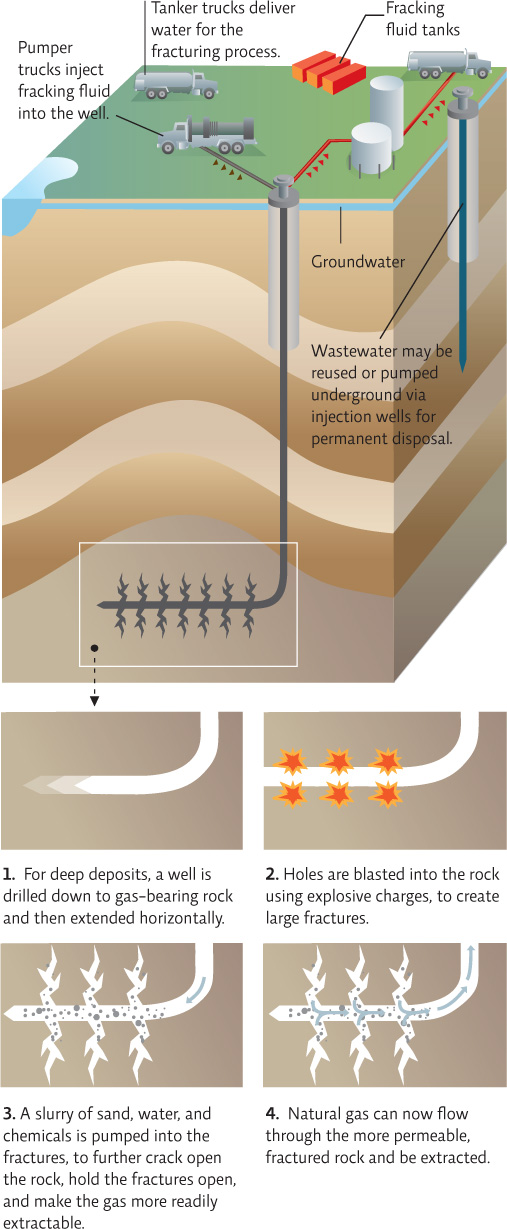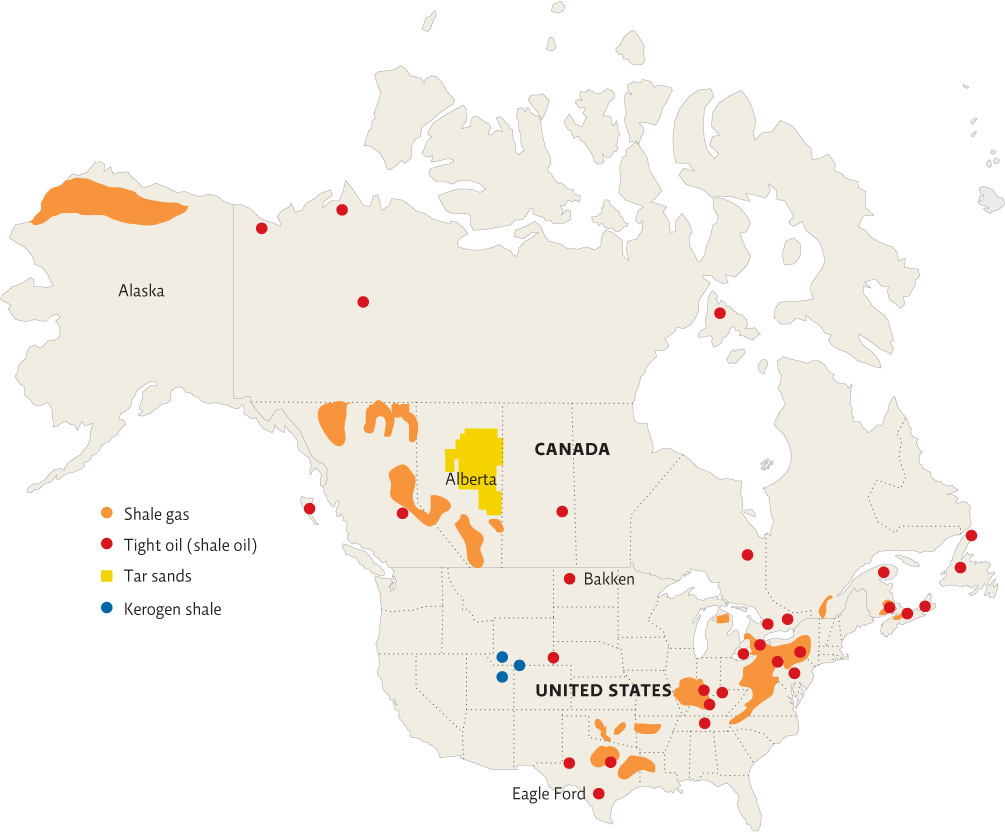Energy producers are turning to unconventional reserves of oil and natural gas.
This is not North Dakota’s first oil boom. Its first oil boom was actually back in the 1950s, when there were still plenty of conventional oil reserves to be tapped. Of course, that boom was much slower and less dramatic. By the time the oil dried up, there were fewer than 1,000 wells in the state. This time around, oil companies are drilling some 25,000 wells per year.
KEY CONCEPT 19.6
Some oil and natural gas deposits that cannot be accessed with conventional wells can be retrieved via fracking.
The tight oil they’re harvesting is considered an unconventional source of oil. It was not previously accessible because the oil, though abundant, is widely dispersed within the rock formations where it is found and cannot be retrieved using conventional oil wells. But those reserves can be tapped with fracking.
Fracking involves drilling thousands of feet straight down into ancient rock beds and then turning the drilling apparatus to drill horizontally into the gas- or oil-bearing rock formation. Several horizontal wells are drilled, in all directions, and each may reach 1.5 kilometers (1 mile) in length. As drilling progresses, steel pipes are inserted into the wellbores and encased in several inches of concrete. Once all the pipes and casings are in place, explosive charges are detonated to perforate the pipe and casing of each horizontal well and to create openings, or “fractures,” in the rock through which oil can flow. Next, between 15 and 20 million of liters of water containing a mix of sand and chemicals (some of them toxic) are injected into the well under high pressure. The chemical additives serve various purposes: Disinfectants kill bacteria (there are bacteria deep within rock!) that might foul fracking equipment. Hydrochloric acid helps dissolve minerals and forms initial cracks in the rock. Formic acid and acetaldehyde prevent corrosion of the pipes, and petroleum distillates help reduce friction. Detergents and salts are added as lubricants and stabilizers, and alcohols or ethylene glycol (antifreeze) serve as winterizing agents. The sand enters the small fractures, holding them open, while the water helps flush out the oil or natural gas in the deposit. The water mixture returns to the surface, followed by the oil and/or gas. The concrete casing is thickest close to the surface and in the groundwater region to prevent the chemicals from leaking into the surrounding soil and water. INFOGRAPHIC 19.7
Unconventional deposits of natural gas and oil can be accessed via fracking. Concerns about surface and groundwater contamination make this a contentious resource in populated areas.


Suppose you are a homeowner. An oil company approaches you, offering to lease your land in order to install a fracking well. What questions would you have for the company as you consider what to do?
Answers will vary but might include: How much land would be needed? How close will it be to homes? How noisy or polluting will it be? How long will the well be used? How much money would I make? What rights do I have once I sign the lease? What safeguards are in place to prevent accidents or water pollution? What is your safety record?
Fracking technology is used to access unconventional reserves of natural gas that occur in a wide variety of places throughout the United States; the most productive unconventional reserve is the Marcellus Shale that underlies much of Pennsylvania and New York. Currently, the United States leads the world in fracking, recovering enough natural gas and oil to change the global market for these fossil fuels. In 2001, fracking for natural gas only accounted for 2% of total U.S. natural gas production; in 2013, the United States was the leading exporter of natural gas, and fracking gas made up 40% of its total production. This increased production caused natural gas prices to fall, which made it a more attractive fuel for U.S. electricity production— even replacing some coal. Global oil markets, too, have responded to the large quantities emerging from the fracking oil fields of North Dakota and Texas with slightly lower and more stable prices.
While productive, the oil and gas shale deposits aren’t the only types of unconventional reserves; there’s also crude bitumen—a heavy black oil that is often trapped in sticky, dense conglomerations of sand or clay known as tar sands, or oil sands. Alberta, Canada, is home to the largest tar sand reserve; with 170 billion barrels of oil, it is the third-largest proven oil reserve in the world. In 2012, Alberta produced 1.9 million barrels of synthetic crude oil per day from the tar sands—much of it shipped to the United States.
tar sands/oil sands
Sand or clay formations that contain a heavy-density crude oil (crude bitumen); extracted by surface mining.
There is another unconventional type of oil known as kerogen shale, or oil shale (not to be confused with shale oil, referred to as tight oil in this chapter to help avoid confusion). Kerogen shale deposits are compressed sedimentary rocks that contain kerogen, an organic compound that is undergoing the chemical change into hydrocarbons; it exists as dry matter but can be converted to an oil-like liquid when the rock is heated. Primarily on federal lands in the United States, kerogen shale deposits are huge, with an estimated 1.23 trillion barrels of oil, almost 40 times the nation’s proven oil reserves. Currently, retrieving kerogen shale is not economically feasible. INFOGRAPHIC 19.8
There are vast reserves of nonconventional petroleum and natural gas deposits like tar sands, tight oil, and shale gas, but they are more costly and environmentally damaging to extract than conventional deposits and have all the pollution problems associated with burning petroleum.


Why is there so much overlap between the location of tight oil deposits and shale gas deposits?
Oil and natural gas are formed under similar circumstances from the same starting material. These particular shale deposits probably formed at the same time and contain both oil and natural gas.
kerogen shale/oil shale
Rocks that contain kerogen, a mix of solid organic material that can be converted to a liquid fossil fuel for extraction.